The AMD Ryzen 3 1300X and Ryzen 3 1200 CPU Review: Zen on a Budget
by Ian Cutress on July 27, 2017 9:30 AM EST- Posted in
- CPUs
- AMD
- Zen
- Ryzen
- Ryzen 3
- Ryzen 3 1300X
- Ryzen 3 1200
Benchmarking Performance: CPU Rendering Tests
Rendering tests are a long-time favorite of reviewers and benchmarkers, as the code used by rendering packages is usually highly optimized to squeeze every little bit of performance out. Sometimes rendering programs end up being heavily memory dependent as well - when you have that many threads flying about with a ton of data, having low latency memory can be key to everything. Here we take a few of the usual rendering packages under Windows 10, as well as a few new interesting benchmarks.
All of our benchmark results can also be found in our benchmark engine, Bench.
Corona 1.3: link
Corona is a standalone package designed to assist software like 3ds Max and Maya with photorealism via ray tracing. It's simple - shoot rays, get pixels. OK, it's more complicated than that, but the benchmark renders a fixed scene six times and offers results in terms of time and rays per second. The official benchmark tables list user submitted results in terms of time, however I feel rays per second is a better metric (in general, scores where higher is better seem to be easier to explain anyway). Corona likes to pile on the threads, so the results end up being very staggered based on thread count.
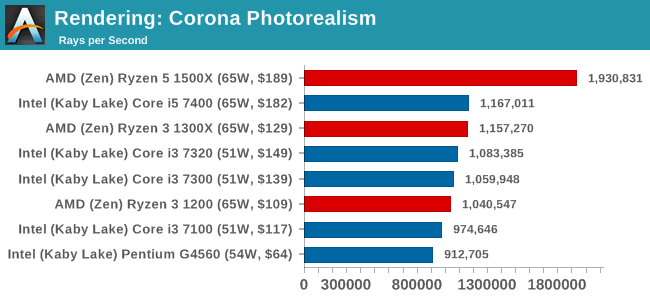
Blender 2.78: link
For a render that has been around for what seems like ages, Blender is still a highly popular tool. We managed to wrap up a standard workload into the February 5 nightly build of Blender and measure the time it takes to render the first frame of the scene. Being one of the bigger open source tools out there, it means both AMD and Intel work actively to help improve the codebase, for better or for worse on their own/each other's microarchitecture.
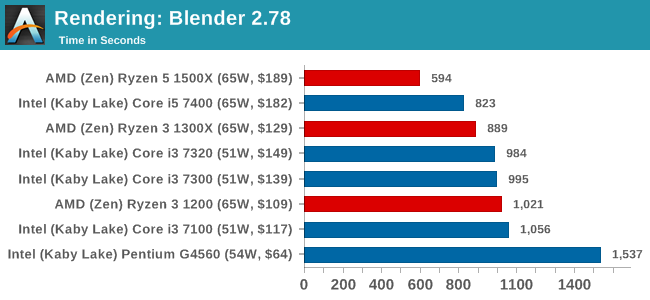
LuxMark v3.1: Link
As a synthetic, LuxMark might come across as somewhat arbitrary as a renderer, given that it's mainly used to test GPUs, but it does offer both an OpenCL and a standard C++ mode. In this instance, aside from seeing the comparison in each coding mode for cores and IPC, we also get to see the difference in performance moving from a C++ based code-stack to an OpenCL one with a CPU as the main host.
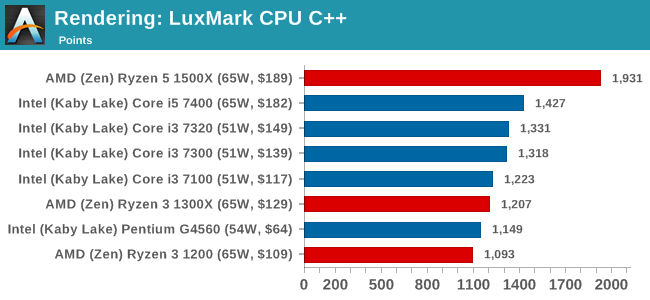

POV-Ray 3.7.1b4: link
Another regular benchmark in most suites, POV-Ray is another ray-tracer but has been around for many years. It just so happens that during the run up to AMD's Ryzen launch, the code base started to get active again with developers making changes to the code and pushing out updates. Our version and benchmarking started just before that was happening, but given time we will see where the POV-Ray code ends up and adjust in due course.
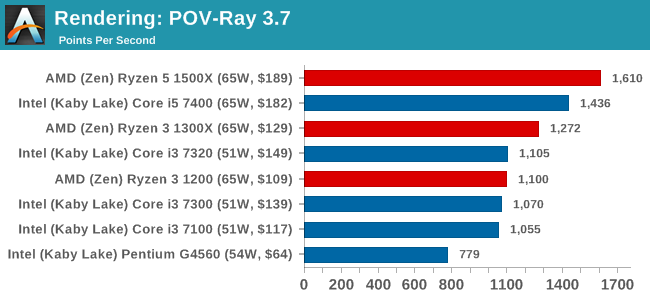
Cinebench R15: link
The latest version of CineBench has also become one of those 'used everywhere' benchmarks, particularly as an indicator of single thread performance. High IPC and high frequency gives performance in ST, whereas having good scaling and many cores is where the MT test wins out.
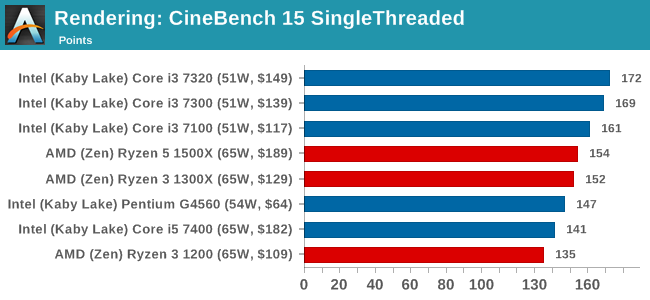
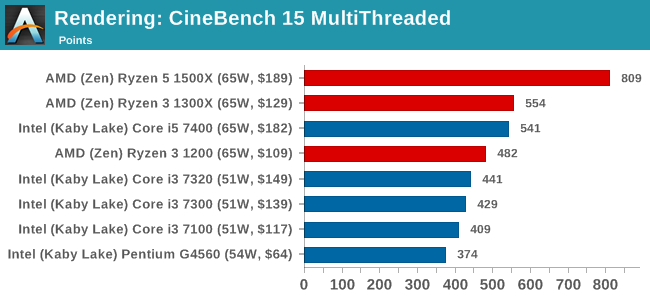










140 Comments
View All Comments
Ian Cutress - Thursday, July 27, 2017 - link
lol yup, just saw it. Should be 889, not 89.T1beriu - Thursday, July 27, 2017 - link
Congrats on getting the review out on day one!Blender 2.78 chart has wrong result number for 1300X.
http://images.anandtech.com/graphs/graph11658/8919...
Ian Cutress - Thursday, July 27, 2017 - link
We always get CPU reviews out on day one... ;)Blender is fixed.
T1beriu - Thursday, July 27, 2017 - link
Another chart that needs a little bit of edit - "Title" at the bottom.http://images.anandtech.com/doci/11658/combined_cp...
jjj - Thursday, July 27, 2017 - link
For value,in the real world mixed or lightly threaded should have more weigh, especially in the lower end where low core count and lower clocks can be a limitation.For power, when comparing diff numbers of cores , the system power is important too- lets say you can have a dual core system at 60W vs a quad at 70W peak. Even if the dual core is more efficient, at the system level the quad wins.
nathanddrews - Thursday, July 27, 2017 - link
Performance is nice and price is good IF you have a dGPU. For entry-level gaming/HTPC builds, that Intel IGP is more valuable than most people think, especially given the amount of media decode/encode power it has. All you need is i3 and you can be watching Netflix 4K or UHD Blu-ray and then switch to playing 1080p 60fps Rocket League. You can do the latter with R3 if you buy a dGPU, but sadly there's no current way to do Netflix or UHD Blu-ray without Intel SGX.MajGenRelativity - Thursday, July 27, 2017 - link
I think that's why AMD also picked this time to release Bristol Ridgemczak - Thursday, July 27, 2017 - link
Yes, imho these cpus are only mildly interesting.In this cpu performance segment, chances are pretty high that a integrated gpu would be good enough. (Sure there's always someone who has a need for high cpu / low gpu, or low cpu / high gpu performance, but I don't think that's the norm.)
So, if a integrated gpu is good enough, with factoring in the cost of an additional gpu amd can't compete on price here. The really interesting competition from AMD in this lower end market has to come from Raven Ridge APUs.
nathanddrews - Thursday, July 27, 2017 - link
In the wise words of Peter Klavin, "Totes McGotes."T1beriu - Thursday, July 27, 2017 - link
Done! Thanks.When should I come back for the full review?